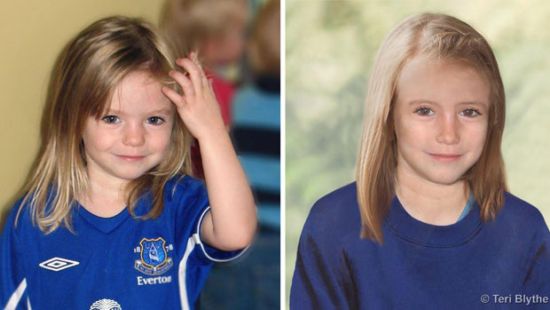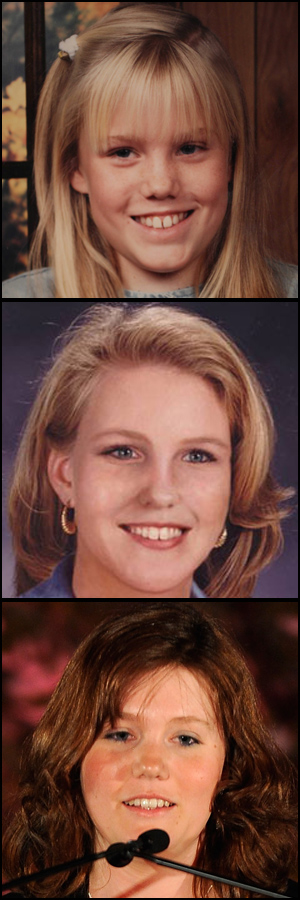|
Adding 5 years to appearance of missing girl takes skill, artistry
 |
|
The two
images released by the Metropolitan Police shows a photo of four year
old missing child Madeleine McCann and an age progression computer
generated image of her at 9 years old. (Teri Blythe/Associated Press) |
Madeleine may be alive, police say
A forensic artist who "age enhanced" an image of Madeleine McCann, the
young girl who disappeared while on a family vacation in Portugal,
needed to combine her knowledge of anatomy and forensics with a little
bit of artistry.
"It’s not quite as straightforward as putting a whole bunch of photos in
[a computer], pressing a few buttons and out it pops," Teri Blythe told
CBC News in a phone interview from her U.K. home. "It's using the
training I have, the experience I have and knowledge I have of how faces
change. But it's also using the artistic side of it to actually
manipulate photos into a new face."
Blythe was asked by the Metropolitan Police Service to create the image,
which was made public ahead of Madeleine’s ninth birthday on May 12.
Madeleine has been missing since she disappeared a few days before her
fourth birthday from a holiday apartment at the Ocean Club in Praia da
Luz on May 3, 2007.
A number of law enforcement agencies make use of age progression
technology when looking for missing children, and it has been used in
high-profile cases such as that of Jaycee Dugard, the California girl
who was kidnapped at age 11 and held captive for 18 years.
For example, the RCMP’s National Missing Children Services offer a
computer photo age progression service, in which a trained forensic
artist helps create a portrait, using photographs, of what a missing
child might look like today.
Blythe, whose academic background is in human anatomy, forensic
anthropology, and facial imaging, has been a forensic artist for 10
years. She worked with Britain’s Missing People Charity and received
training at the Virginia-based National Center for Missing and Exploited
Children, as well as the FBI and London police.
She said she uses basic photo manipulation software on her computer, the
kind of program that anyone has access to.
Blythe said she starts by collecting as many photos as possible of the
missing person, including recent photos of the family.
“Basically you’re looking for direct family members,” she said. "I don’t
tend to look at aunts or uncles or grandparents because they're an extra
step removed."
 |
|
The top image shows a
picture of Jaycee Dugard around the age she was kidnapped while walking
to school. The middle picture, released by Natational Center for Missing
and Exploited Children, shows an age-enhanced image of Jaycee created in
2006. The bottom image is a picture of Jaycee in 2012. (Top image - Carl
Probyn/AP - Middle image - NCMEC Bottom image - Andrew H. Walker/Getty
Images |
Getting information from the parents, if possible, can be key in
creating an age-enhanced image of a child, she said.
"Who did they look like, who did they not look like, which features are
similar — that kind of thing. So when I'm changing the image I can bear
that in mind."
For Madeleine, Blythe said, she had access to a large range of photos of
the girl and her family and used the whole range for reference.
She used not only recent pictures of her parents, but snapshots when
they were young and at age nine, which would be Madeleine's current age.
“For a child especially, it’s not only superficial things that are
changing, but obviously the skull is still growing and the teeth are
changing — that kind of things. Using reference photos against parents
will at least give us an indication of the right proportion of the
face."
Blythe looks for the best and clearest image available of the missing
person.
Once she has the pictures, Blythe begins using the software to
manipulate the photo, stretching the face to the right proportions for
that age while trying to maintain the key features of the individual to
make sure they are still recognizable.
Generic clothing and hairstyles are also used to avoid distracting from
the face, she said.
At a certain stage in the process, she solicits feedback from the family
members to make sure they can still recognize their child.
“And if they have any comments like ‘We think she looks more like so and
so and we think her nose would be longer.’ Any of those kinds of details
are helpful to get from the family, then I can make extra tweaks to the
image.”
Blythe said that with Madeleine, once she completed the first stage of
aging, she sent the image to the family. She said they were able to
suggest details or tweaks they thought would improve the likeness.
“Once we had worked on this they were happy with the result, but of
course, as you can imagine for any parent, this is very strange process
to go through,” she said. |



